Key takeaways:
- Anti-war activism thrives on personal stories and shared experiences, creating emotional connections that fuel collective advocacy for peace.
- Community engagement is crucial, fostering trust and educating individuals about the true costs of war, inspiring action at the local level.
- Collaboration with like-minded organizations enhances outreach and deepens conversations around interconnected issues, broadening the impact of peace initiatives.
- Establishing a safe environment for storytelling encourages dialogue, helping to bridge differences and cultivate empathy among diverse individuals.
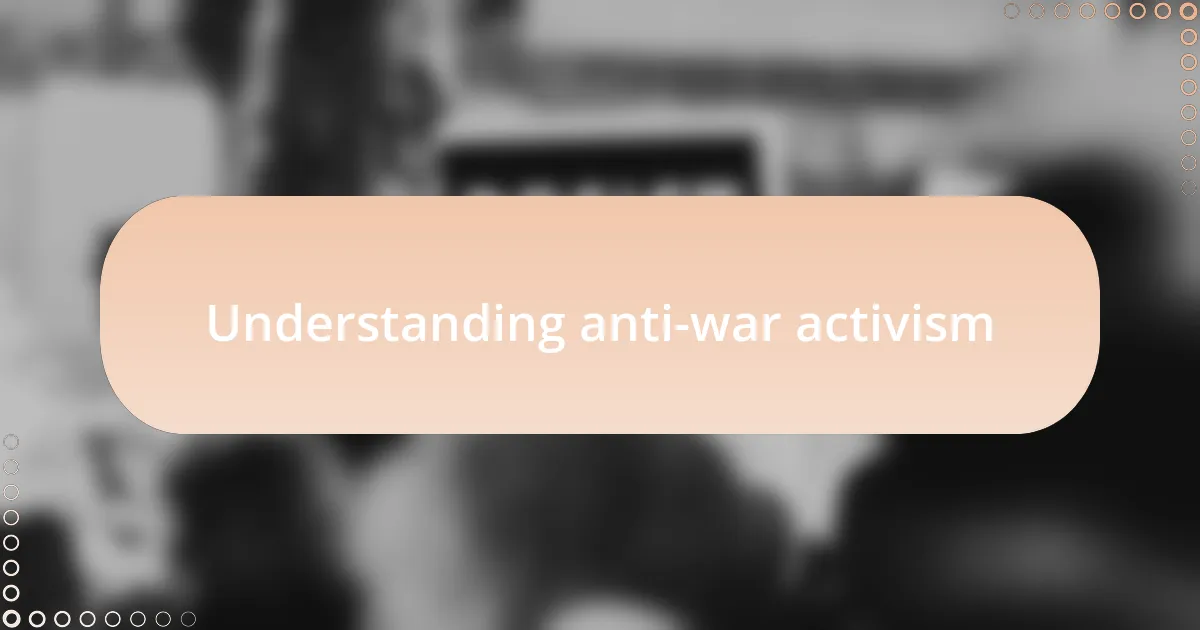
Understanding anti-war activism
Anti-war activism is rooted in a deep belief that war inflicts immense suffering on both individuals and communities. I remember attending a local rally where the palpable energy of collective voices chanting against violence struck a chord in me; it reminded me that each plea for peace is a lifeline thrown to those caught in the chaos of conflict. What drives people to stand up and speak out? It’s this undeniable understanding that the impacts of war extend far beyond battlefields, affecting families, economies, and entire generations.
At its core, anti-war activism combines moral, political, and emotional dimensions. I’ve seen people from diverse backgrounds come together, united by the conviction that peaceful resolutions are always preferable. This raises an interesting question: how can a singular, heartfelt perspective influence the larger movement? In my experience, it’s the vulnerability of sharing personal stories that resonates with others, creating a profound connection that fuels activism.
One key aspect of understanding anti-war activism is addressing the complexities behind the motivations of those involved. I often reflect on the conversations I’ve had with veterans who oppose war, sharing their first-hand experiences of trauma and loss. Their stories provide a haunting reminder of the human cost of conflict—how do we ensure that these voices are heard and valued in broader discussions? Ultimately, understanding anti-war activism is about recognizing the emotional weight carried by individuals who advocate for peace, reminding us all that we have a shared responsibility to foster dialogue and understanding.
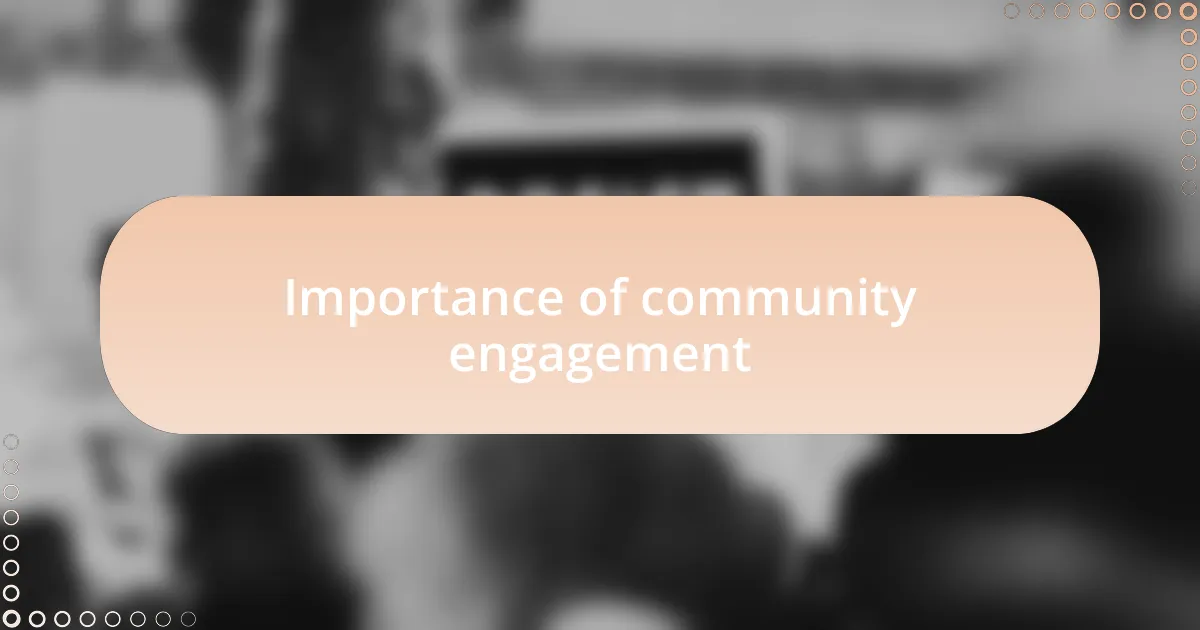
Importance of community engagement
Engaging with the community is paramount in anti-war activism, as it builds a foundation of trust and solidarity. In my own experience, organizing local discussions allowed me to witness diverse perspectives emerge, transforming individual concerns into a collective narrative. Have you ever attended a meeting where the air buzzed with shared fears and hopes? It’s this very connection that not only strengthens our resolve but also amplifies our collective voice against war.
When community members participate actively, they become change agents in their own right. I remember a workshop we hosted focused on conflict resolution strategies. Participants left feeling empowered, equipped with tools to address tensions in their neighborhoods peacefully. Isn’t it inspiring to think that fostering awareness at the local level can cultivate an environment where empathy prevails over aggression?
Moreover, community engagement serves to educate and inform, debunking myths surrounding war and its supposed necessity. I once facilitated a dialogue with local students, and their questions genuinely surprised me—some had never considered the human cost of military conflict. By encouraging curiosity and open conversation, we empower individuals to seek alternatives to war, shaping a more peaceful future together.
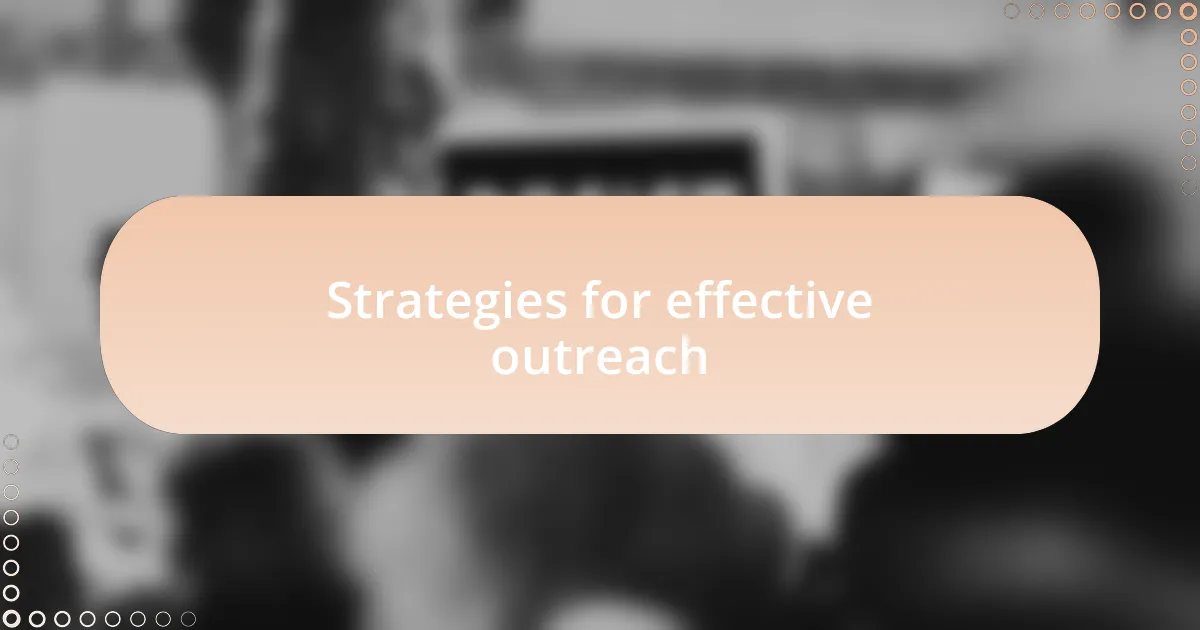
Strategies for effective outreach
One effective strategy I’ve found in outreach involves hosting community events that resonate with local interests. For instance, I organized a film screening of a documentary on the impacts of war, followed by a discussion panel featuring veterans and peace activists. The turnout was incredible, and the conversations that ensued were heartfelt and eye-opening. Have you ever seen how a shared experience, like watching a film, can bridge differences and spark deep conversations? It’s a powerful way to highlight the human cost of war and encourage collective reflection.
Social media, too, plays a vital role in outreach efforts. I started a campaign where community members could share their thoughts and artwork related to peace on a dedicated platform. The response was overwhelming; people shared stories, poems, and visuals that stirred emotional connections. Don’t you think that when individuals express their feelings about war creatively, it not only fosters understanding but also inspires action? This approach encourages a sense of belonging and shared purpose that is crucial for mobilizing support for anti-war initiatives.
Lastly, collaboration with local organizations can amplify outreach. I partnered with a local school to integrate peace education into their curriculum, reaching students and educators alike. Witnessing students engage in discussions about the consequences of war and explore peaceful solutions reminded me how vital it is to plant these seeds early. Isn’t it fulfilling to think that these young minds can grow into advocates for peace? By creating partnerships, we can broaden our reach and amplify the message in ways that resonate deeply within the community.
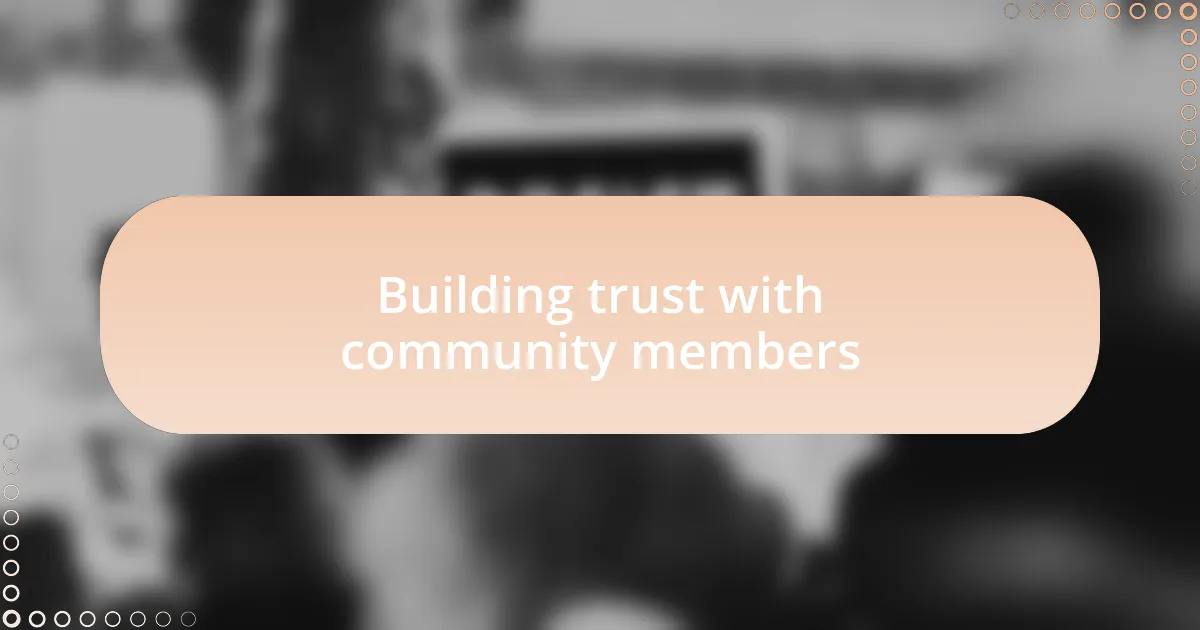
Building trust with community members
Building trust with community members is fundamental to fostering meaningful engagement. I remember the first time I reached out to my neighbors after moving to a new area. To break the ice, I organized a casual coffee meet-up where we could share stories and discuss our thoughts on local issues, including war and peace. That laid-back approach not only helped me connect but also encouraged others to open up about their experiences and concerns. Have you noticed how sharing a cup of coffee can soften barriers and create a safe space for dialogue?
Additionally, transparency plays a crucial role in building trust. I once led a community forum where I actively invited feedback on our upcoming anti-war campaign. By openly discussing our goals and inviting differing opinions, I fostered a sense of ownership among participants. People felt valued for their input, and I could see how their trust in our mission grew when they realized their voices truly mattered. Isn’t it amazing how a simple act of seeking advice can transform a group into a supportive community?
Moreover, consistency in communication is key. I made it a point to send out regular newsletters that not only highlighted our activities but also shared personal reflections about the impact of our efforts. By sharing both successes and challenges, I demonstrated dedication and genuine investment in our shared cause. Trust develops over time, and I’ve learned that along with active participation, staying accountable and relatable is essential in nurturing lasting relationships. How do you think regular updates influence a community’s trust in its leaders?
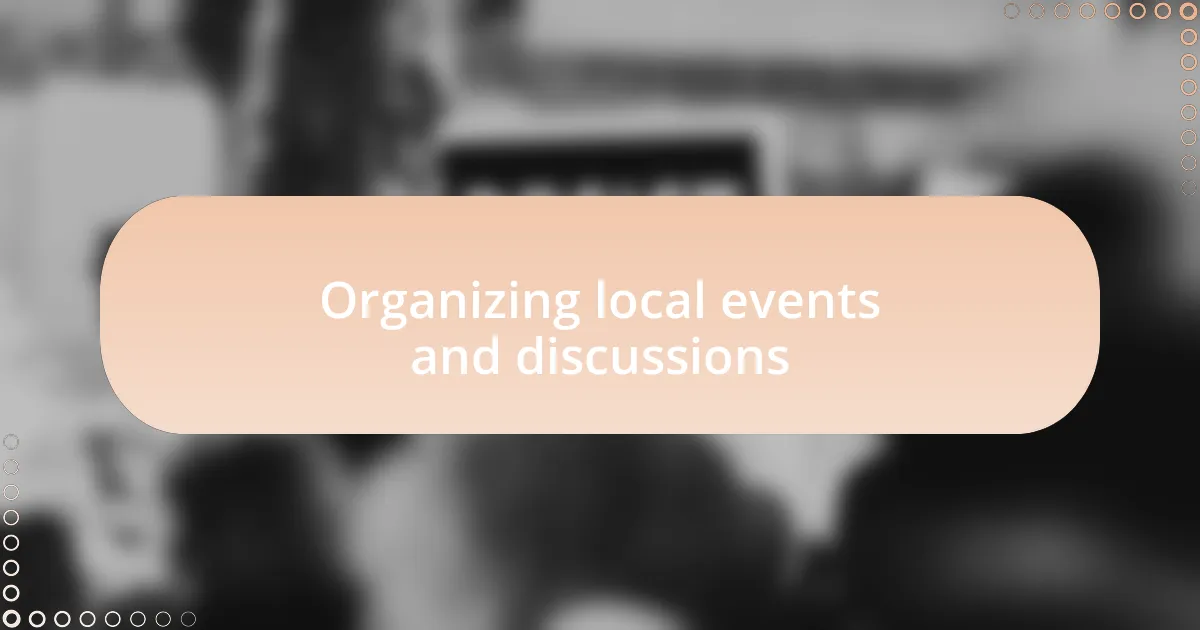
Organizing local events and discussions
Organizing local events and discussions is a dynamic way to engage with the community and stimulate thought. I vividly recall hosting a town hall gathering focused on the implications of militarization on our everyday lives. The room was filled with people from various backgrounds, each sharing personal stories about how war had touched their lives. Those heartfelt exchanges not only deepened our understanding but also created a profound collective empathy. Have you ever noticed how the power of shared experiences can bring strangers closer together?
When planning an event, I found that the little details can make a big difference. For instance, I decided to incorporate breakout sessions where participants could dive deeper into specific topics, such as veterans’ experiences or the impact of war on local youth. This approach encouraged more intimate conversations and gave everyone a chance to feel heard. How often do we miss out on these rich dialogues simply because we stick to large group formats? The lively discussions that emerged sparked new ideas and initiatives within our community, proving to me that smaller can indeed be more effective.
Moreover, I learned that follow-up is crucial after an event. After hosting a discussion on peaceful advocacy, I made it a point to send a summary of key takeaways and actionable steps to all attendees. I could sense renewed enthusiasm and commitment as people realized the potential for real change. It’s incredible to see how a simple recap can reignite passion and remind us of our shared mission. How do you think the act of reflecting on our gatherings can help solidify our community’s dedication?
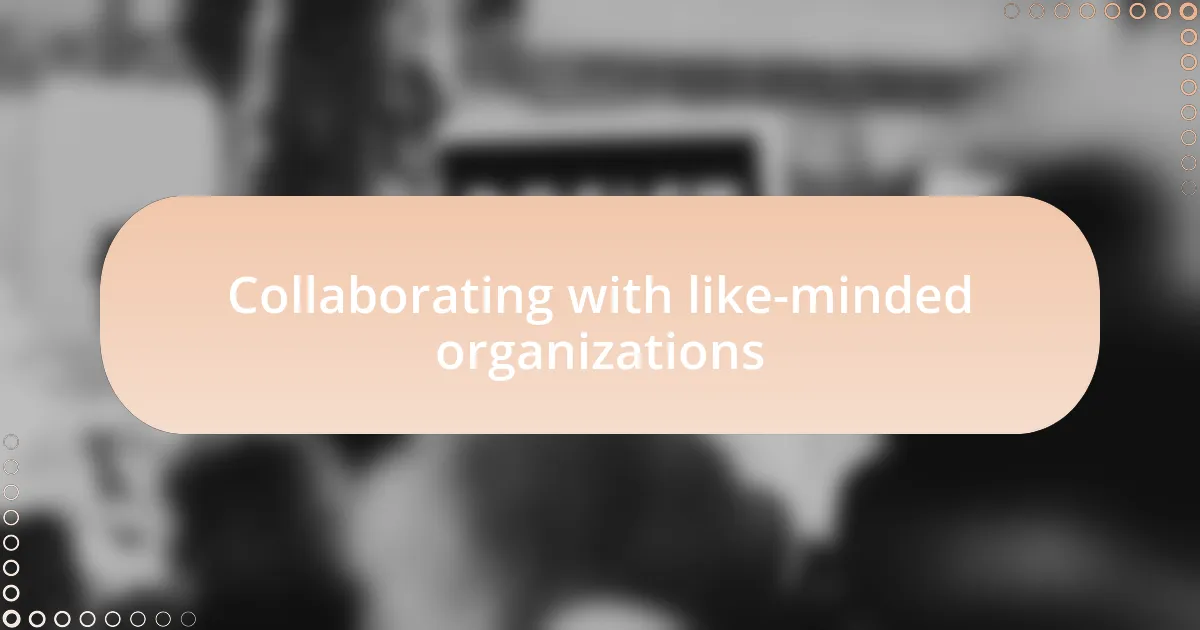
Collaborating with like-minded organizations
Collaborating with like-minded organizations can amplify our reach and influence in ways we often overlook. I remember partnering with a local peace group that shared our vision of promoting non-violence. Together, we organized a community art show that featured works focused on peace and reconciliation. This collaboration not only attracted a wider audience but also fostered deeper connections among attendees, sparking conversations about our shared values. Have you ever thought about how much more powerful we can be when we unite our efforts?
It’s fascinating how different organizations can bring unique strengths to the table. For example, when I collaborated with an environmental organization, we explored the links between militarism and environmental degradation. By integrating these perspectives into our discussions, we could engage a broader audience and highlight the intersections between our causes. This experience taught me the importance of networking—not just for resources, but for idea exchange. What might we learn from other groups if we dared to reach out and collaborate?
I also discovered that maintaining open communication and shared goals is essential for successful partnerships. During one project, we set up regular check-ins which allowed us to stay aligned and adjust our strategies as needed. One time, I suggested a joint webinar on the effects of war on both people and the planet. It turned out to be a hit and strengthened our collaboration. How often do we overlook the simple fact that clear communication can transform relationships?
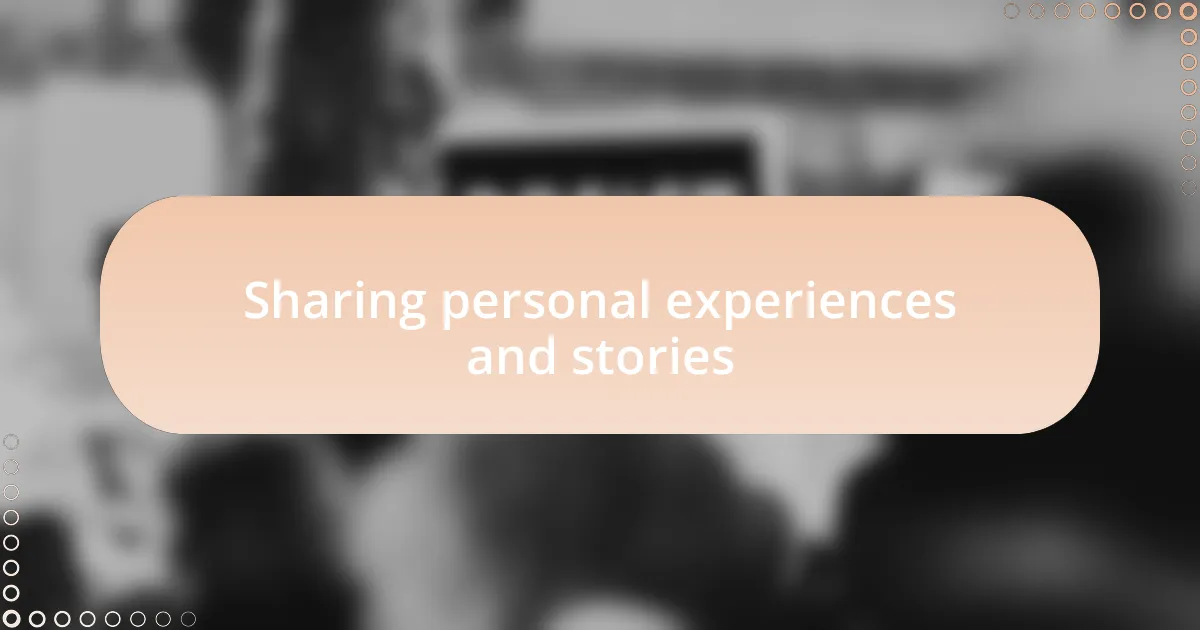
Sharing personal experiences and stories
Sharing personal experiences can be a powerful tool in anti-war activism. I vividly recall a gathering where I shared my story as a child witnessing the effects of conflict on my community. The room went silent, and I could see the impact my words had on others; it connected us in a shared vulnerability, igniting empathy and encouraging others to share their stories. Have you ever felt that rush of connection when you open up about your own experiences?
Storytelling also fosters understanding across different backgrounds and perspectives. I remember chatting with a veteran who spoke about his regrets after returning from service. His candid account challenged stereotypes and encouraged us to consider the human cost of war from all angles. I often wonder how many more conversations could shift our understanding if we only dared to share our scars openly.
Creating a safe environment for sharing is essential. In one community forum I led, I invited participants to write down their experiences anonymously, which encouraged even the most hesitant individuals to contribute. The collective outpouring of stories was overwhelming and fostered a sense of solidarity that I had never experienced before. Have you thought about how sharing our truths can unlock the door to deeper discussions about peace?